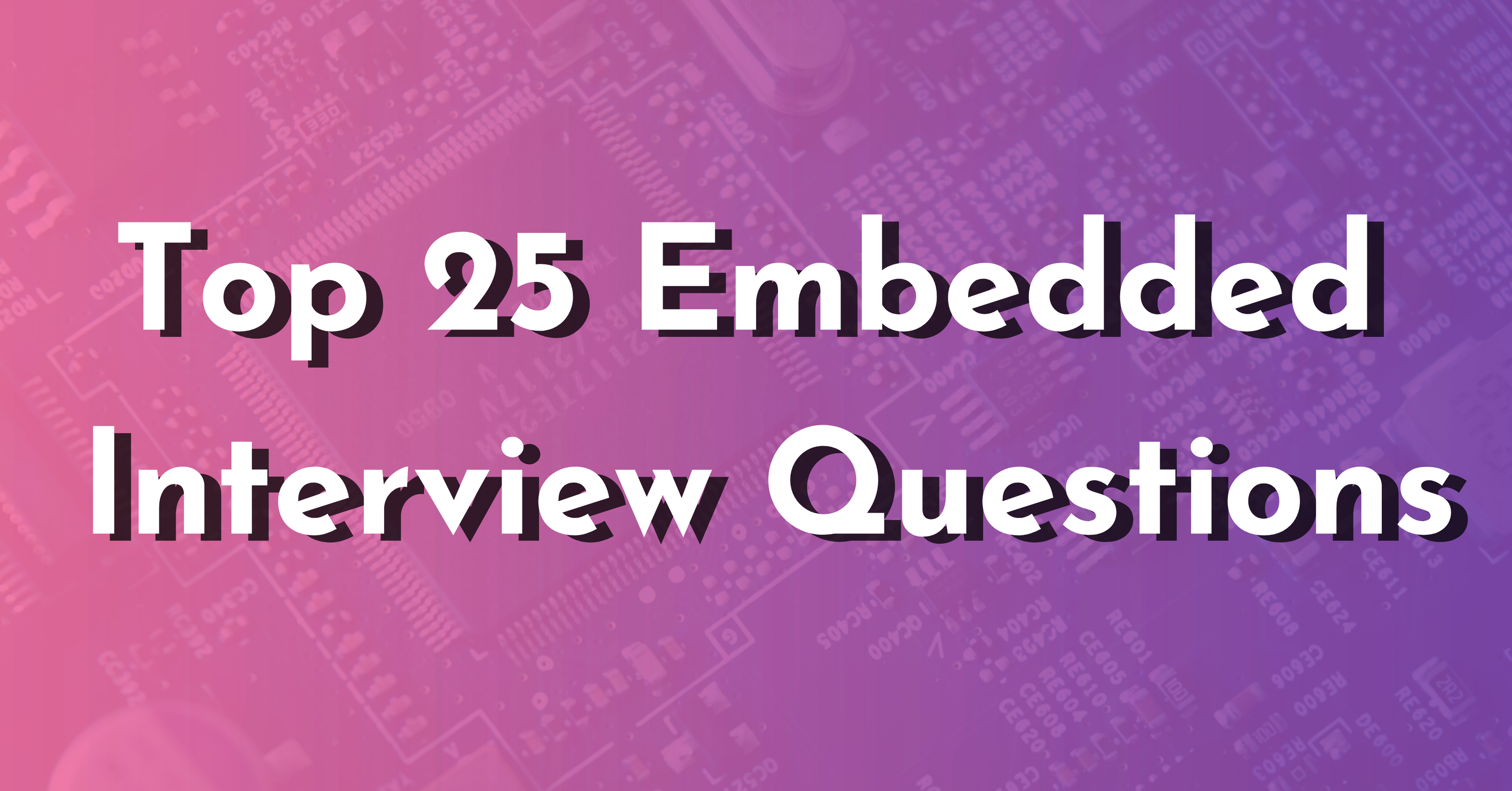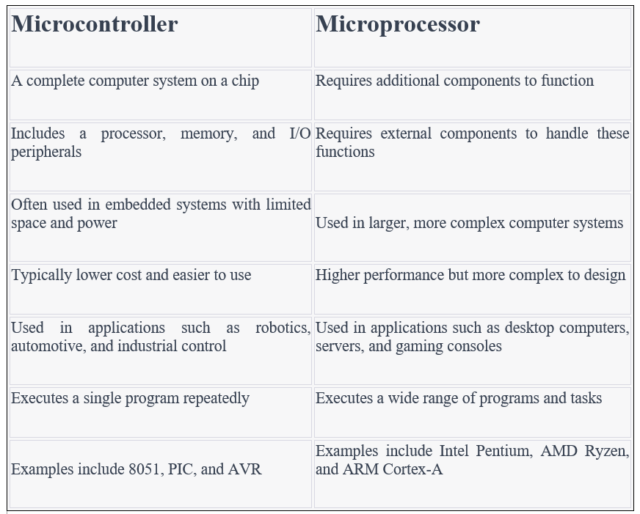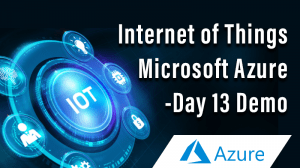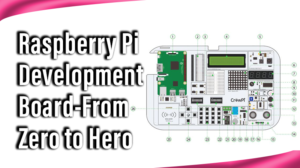
Top 25 Embedded Interview Questions
List of Embedded Interview Questions
This blog post contains Top 25 Embedded Interview Questions for electronics engineers.
- What is an embedded system, and how is it different from a general-purpose computer system?
- What are the different components of an embedded system, and how do they interact with each other?
- What is an interrupt, and how is it used in embedded systems?
- What is the difference between a microcontroller and a microprocessor?
- What is an RTOS, and how is it used in embedded systems?
- What is a device driver, and how does it work in an embedded system?
- What is a boot loader, and how does it work in an embedded system?
- What is a watchdog timer, and how is it used in embedded systems?
- What is the role of a compiler in embedded systems development?
- What is a cross-compiler, and how is it different from a native compiler?
- What is an assembler, and how is it used in embedded systems development?
- What is a linker, and how is it used in embedded systems development?
- What is a debugger, and how is it used in embedded systems development?
- What is a JTAG interface, and how is it used in embedded systems development?
- What is an embedded Linux system, and how is it different from other embedded systems?
- What is an embedded system bus, and how is it used in embedded systems development?
- What is a memory-mapped I/O, and how is it used in embedded systems?
- What is DMA, and how is it used in embedded systems?
- What is a serial communication protocol, and how is it used in embedded systems?
- What is a CAN bus, and how is it used in embedded systems?
- What is an SPI bus, and how is it used in embedded systems?
- What is an I2C bus, and how is it used in embedded systems?
- What is a UART, and how is it used in embedded systems?
- What is a GPIO, and how is it used in embedded systems?
- What is an ADC, and how is it used in embedded systems?
Embedded Interview Questions 1 : What is an embedded system, and how is it different from a general-purpose computer system?
An embedded system is a specialized computer system designed to perform a specific task. It is typically embedded within a larger device or system, such as a car, a medical device, or an industrial machine. The main purpose of an embedded system is to control and monitor the functions of the larger device or system, often in real-time.
Embedded systems differ from general-purpose computer systems in several ways. First, embedded systems are typically designed for a specific task or set of tasks, while general-purpose computer systems are designed to be versatile and capable of performing a wide range of tasks. Second, embedded systems are often designed to operate in real-time, meaning that they must respond quickly to external inputs and produce outputs in a timely manner. General-purpose computer systems are not always required to operate in real-time.
Another difference between embedded systems and general-purpose computer systems is that embedded systems are often designed to operate with limited resources, such as processing power, memory, and energy. This is because embedded systems are often required to operate for long periods of time without being connected to a power source or other external resources. General-purpose computer systems, on the other hand, typically have access to more resources and are not as constrained by power or memory limitations.
In summary, an embedded system is a specialized computer system that is designed to perform a specific task within a larger device or system. Embedded systems differ from general-purpose computer systems in terms of their specific design, real-time requirements, and resource limitations.
Embedded Interview Questions 2 : What are the different components of an embedded system, and how do they interact with each other?
An embedded system is a computer system designed to perform a specific task or function. It typically consists of several components that work together to achieve the desired functionality. The key components of an embedded system include:
1. Processor: The processor is the central component of an embedded system, responsible for executing instructions and performing calculations.
2. Memory: Memory is used to store data and program code that the processor accesses during operation. It includes both volatile memory, such as RAM, and non-volatile memory, such as flash memory.
3. Input/output (I/O) interfaces: I/O interfaces enable the embedded system to communicate with the outside world, such as sensors, actuators, and communication devices. They include both digital and analog interfaces, such as UART, SPI, I2C, and GPIO.
4. Power supply: Embedded systems require a power supply to operate. This can be provided by batteries, AC power, or other sources.
5. Operating system and software: The operating system and software provide the functionality of the embedded system, controlling the behavior of the processor and managing hardware resources. They may include drivers, libraries, and application software.
The components of an embedded system interact with each other through various communication protocols, such as I/O interfaces and interprocess communication mechanisms. The operating system and software manage these interactions, scheduling tasks, allocating resources, and ensuring that the system functions correctly.
Overall, the different components of an embedded system work together to enable the system to perform its intended function in a reliable and efficient manner
Embedded Interview Questions 3: What is an interrupt, and how is it used in embedded systems?
In embedded systems, an interrupt is a signal that temporarily suspends the normal execution of the program and transfers control to a specific piece of code known as an interrupt handler or interrupt service routine (ISR).
Interrupts are used to handle events that require immediate attention and cannot be handled by the normal flow of the program. For example, an interrupt may be triggered by a hardware event, such as a timer or a sensor reading, or a software event, such as a message received from a communication interface.
When an interrupt occurs, the processor saves the current state of the program, including the instruction pointer and register values, and transfers control to the interrupt handler. The interrupt handler performs the necessary operations to handle the event, such as reading data from a sensor or sending a response to a communication interface. Once the interrupt handler has completed its task, the processor returns to the normal flow of the program.
Interrupts play a crucial role in the real-time behavior of embedded systems, enabling the system to respond quickly and efficiently to external events. They are used to implement time-critical tasks, such as controlling motor speed or handling safety-critical events. Interrupts can also be used to implement multitasking, allowing the processor to switch between different tasks based on their priority.
Overall, interrupts provide a powerful mechanism for handling events in embedded systems, enabling the system to respond quickly and efficiently to changing conditions and ensuring the system’s real-time behavior.
Embedded Interview Questions 4: What is the difference between a microcontroller and a microprocessor?





